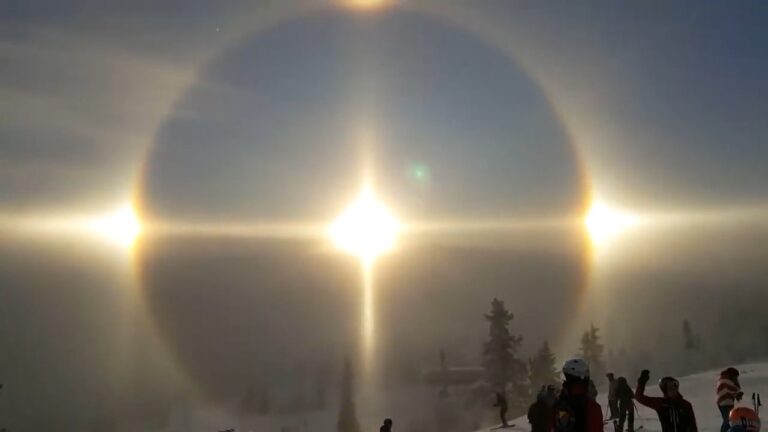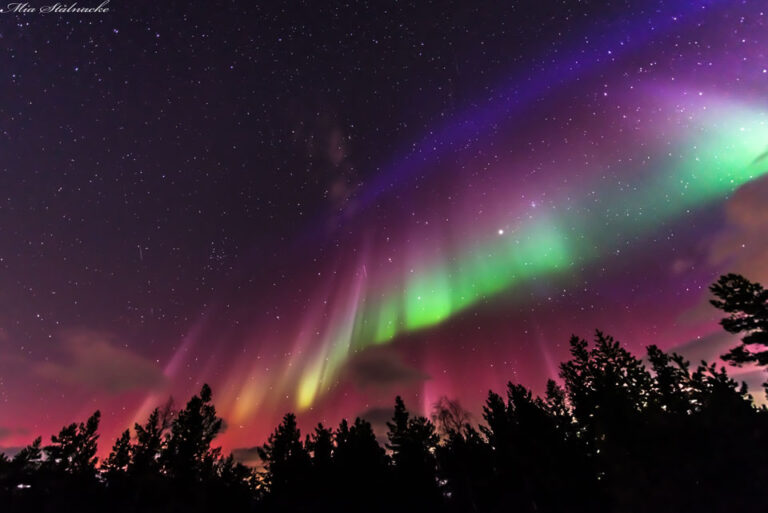瑞典上空的夜光云
See Explanation. Clicking on the picture will download the highest resolution version available.
请参阅说明。单击图片将下载可用的最高分辨率版本。

See Explanation. Clicking on the picture will download the highest resolution version available.
请参阅说明。单击图片将下载可用的最高分辨率版本。

A graphic illustrates hundreds of possible exoplanets, with blue drawings of planets in the middle, red on the right, and tan on the left. Some exoplanets are drawn with rings. Please see the explanation for more detailed information.
这张图展示了数百颗可能的系外行星,中间是蓝色行星图,右侧是红色行星图,左侧是棕褐色行星图。有些系外行星带有行星环。有关更多详细信息,请参阅说明。

A landscape shows the sky above, shallow water in front, and hills to the right. The sunset sky is filled with beautifully multicolored clouds. These clouds are clearly reflected by the calm water in front. Please see the explanation for more detailed information.
在这幅风景画中展现的是上方的天空、前方的浅水和右侧的山峦。夕阳的天空中布满了五彩缤纷的云朵。这些云朵清晰地倒映在前方平静的水面上。

在夜空中可以看到一道巨大的绿色弧线。弧线上方逐渐消失,变成绿色的薄雾,而弧线下方则看不到绿光。背景是布满星星和星座的黑暗天空。前景是白雪和远处的树木。有关更多详细信息,请参阅说明。

2022年10月18日 Milky Way Auroral Flower Image Credit & Copyright: Göran Strand Explanation: Could the stem of our Milky Way bloom into an auroral flower? No, not really, even though it may appear that way in today’s featured all-sky image. On the left, the central plane of our home galaxy extends from the horizon past the middle of the sky. On the right, an auroral oval also extends from the sky’s center — but is dominated by bright green-glowing oxygen. The two are not physically connected, because the aurora is relatively nearby, with the higher red parts occurring in Earth’s atmosphere only about 1000 kilometers high. In contrast, an average distance to the stars and nebulas we see in the Milky Way more like 1000 light-years…

2022年3月22日 A Whale of an Aurora over Swedish Forest Image Credit & Copyright: Göran Strand Explanation: What’s that in the sky? An aurora. A large coronal mass ejection occurred on our Sun earlier this month, throwing a cloud of fast-moving electrons, protons, and ions toward the Earth. Part of this cloud impacted our Earth’s magnetosphere and, bolstered by a sudden gap, resulted in spectacular auroras being seen at some high northern latitudes. Featured here is a particularly photogenic auroral corona captured above a forest in Sweden from a scenic perch overlooking the city of Östersund. To some, this shimmering green glow of recombining atmospheric oxygen might appear like a large whale, but feel free to share what it looks like to you. The unusually quiet…

2021年12月28日 Sun Halo over Sweden Video Credit & Copyright: Håkan Hammar (Vemdalen Ski Resort, SkiStar) Explanation: What’s happened to the Sun? Sometimes it looks like the Sun is being viewed through a giant lens. In the featured video, however, there are actually millions of tiny lenses: ice crystals. Water may freeze in the atmosphere into small, flat, six-sided, ice crystals. As these crystals flutter to the ground, much time is spent with their faces flat and parallel to the ground. An observer may find themselves in the same plane as many of the falling ice crystals near sunrise or sunset. During this alignment, each crystal can act like a miniature lens, refracting sunlight into our view and creating phenomena like parhelia, the technical term for…

2021年03月14日 A Flag Shaped Aurora over Sweden Image Credit & Copyright: Mia Stålnacke Explanation: It appeared, momentarily, like a 50-km tall banded flag. In mid-March of 2015, an energetic Coronal Mass Ejection directed toward a clear magnetic channel to Earth led to one of the more intense geomagnetic storms of recent years. A visual result was wide spread auroras being seen over many countries near Earth’s magnetic poles. Captured over Kiruna, Sweden, the image features an unusually straight auroral curtain with the green color emitted low in the Earth’s atmosphere, and red many kilometers higher up. It is unclear where the rare purple aurora originates, but it might involve an unusual blue aurora at an even lower altitude than the green, seen superposed with a…

2021年02月01日 Lunar Halo over Snowy Trees Image Credit & Copyright: Göran Strand Explanation: Have you ever seen a halo around the Moon? This fairly common sight occurs when high thin clouds containing millions of tiny ice crystals cover much of the sky. Each ice crystal acts like a miniature lens. Because most of the crystals have a similar elongated hexagonal shape, light entering one crystal face and exiting through the opposing face refracts 22 degrees, which corresponds to the radius of the Moon Halo. A similar Sun Halo may be visible during the day. Exactly how ice-crystals form in clouds remains a topic of research. In the featured image taken last week from Östersund, Sweden, a complete lunar halo was captured over snowy trees and…